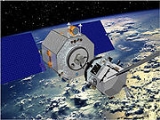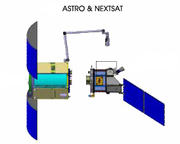
Orbital Express
Encyclopedia

United States
The United States of America is a federal constitutional republic comprising fifty states and a federal district...
Defense Advanced Research Projects Agency
Defense Advanced Research Projects Agency
The Defense Advanced Research Projects Agency is an agency of the United States Department of Defense responsible for the development of new technology for use by the military...
(DARPA) and a team led by engineers at NASA
NASA
The National Aeronautics and Space Administration is the agency of the United States government that is responsible for the nation's civilian space program and for aeronautics and aerospace research...
's Marshall Space Flight Center
Marshall Space Flight Center
The George C. Marshall Space Flight Center is the U.S. government's civilian rocketry and spacecraft propulsion research center. The largest center of NASA, MSFC's first mission was developing the Saturn launch vehicles for the Apollo moon program...
(MSFC). The Orbital Express program was aimed at developing "a safe and cost-effective approach to autonomously service satellites in orbit."
The system consisted of two spacecraft
Spacecraft
A spacecraft or spaceship is a craft or machine designed for spaceflight. Spacecraft are used for a variety of purposes, including communications, earth observation, meteorology, navigation, planetary exploration and transportation of humans and cargo....
: the ASTRO
ASTRO
Autonomous Space Transport Robotic Operations , is an American technology demonstration satellite which was operated as part of the Orbital Express programme. It was used to demonstrate autonomous servicing and refuelling operations in orbit, performing tests on the NEXTSat satellite which was...
servicing satellite, and a prototype modular next-generation serviceable satellite; NEXTSat
NEXTSat
NEXTSat, or Next Generation Satellite and Commodities Spacecraft is an American technology demonstration satellite which was operated as part of the Orbital Express programme. It was used as a target spacecraft for a demonstration of autonomous servicing and refuelling operations performed by the...
.
The mission launched from Cape Canaveral Air Force Station
Cape Canaveral Air Force Station
Cape Canaveral Air Force Station is an installation of the United States Air Force Space Command's 45th Space Wing, headquartered at nearby Patrick Air Force Base. Located on Cape Canaveral in the state of Florida, CCAFS is the primary launch head of America's Eastern Range with four launch pads...
on March 8, 2007, aboard an Atlas V
Atlas V
Atlas V is an active expendable launch system in the Atlas rocket family. Atlas V was formerly operated by Lockheed Martin, and is now operated by the Lockheed Martin-Boeing joint venture United Launch Alliance...
expendable launch vehicle. The launch was part of the United States Air Force
United States Air Force
The United States Air Force is the aerial warfare service branch of the United States Armed Forces and one of the American uniformed services. Initially part of the United States Army, the USAF was formed as a separate branch of the military on September 18, 1947 under the National Security Act of...
Space Test Program
Space Test Program
The Space Test Program is the primary provider of spaceflight for the United States Department of Defense space science and technology community. STP is conducted by the Space Development and Test Wing of the United States Air Force...
STP-1 mission.
Program management and contractors
The Orbital Express program was managed by the Tactical Technology Office (TTO), one of the six technical offices in DARPA.TTO programs included both "Aerospace Systems" such as Orbital Express, and "Tactical Multipliers" such as the "Magneto Hydrodynamic Explosive Munition (MAHEM) program".
ASTRO was developed by Boeing Integrated Defense Systems
Boeing Integrated Defense Systems
Boeing Defense, Space & Security formerly known as Boeing Integrated Defense Systems is a unit of The Boeing Company responsible for defense and aerospace products and services. Boeing Integrated Defense Systems was formed in 2002 by combining the former "Military Aircraft and Missile Systems"...
, and NEXTSat was developed by Ball Aerospace & Technologies Corp..
NASA's involvement was through the Automated Systems and Automated Rendezvous and Docking Division of the Engineering Directorate at MSFC. The MSFC Engineering Directorate also manages the Advanced Video Guidance System (AVGS) for Orbital Express project.
The refueling mechanism was designed, developed and produced by VACCO Industries.
Goals

Space rendezvous
A space rendezvous is an orbital maneuver during which two spacecraft, one of which is often a space station, arrive at the same orbit and approach to a very close distance . Rendezvous requires a precise match of the orbital velocities of the two spacecraft, allowing them to remain at a constant...
, proximity operations and station keeping, capture, docking, fluid transfer (specifically, hydrazine
Hydrazine
Hydrazine is an inorganic compound with the formula N2H4. It is a colourless flammable liquid with an ammonia-like odor. Hydrazine is highly toxic and dangerously unstable unless handled in solution. Approximately 260,000 tons are manufactured annually...
on this mission), and ORU (Orbit Replaceable Unit) transfer. A prime military mission would be to refuel reconnaissance satellites so they can improve coverage, increase surprise and be more survivable.
The fluid (fuel) and ORU (battery) transfers were completed successfully at the lowest levels of spacecraft autonomy. Subsequent transfers over a three month period were intended to demonstrate greater autonomy.
End of mission
The final rendezvous and docking between the two spacecraft occurred on 29 June 2007. This was followed by the final demonstration, the changeout of a flight computer aboard ASTRO. NASA's plans for an extended mission were abandoned. The two craft demated for a final time, with ASTRO backing out to greater than 400 km (248.5 mi) in a test of sensor performance. Following this the craft performed a rendezvous to a standoff, where decommissioning took place. The NEXTSat spacecraft was deactivated on 21 July, when its computers were turned off, and solar panels pointed away from the Sun. Subsequently, ASTRO vented its Hydrazine propellant, and was deactivated on 22 July 2007. The satellites were left to decay naturally. NextSat is expected to take five years to decay, whilst ASTRO is expected to take fifteen years.External links
- DARPA Orbital Express web page 1 web page 2
- Boeing's Orbital Express web page
- Ball Aerospace's Orbital Express web page
- MDA's Orbital Express web page
- Global Security's Orbital Express web page
- Orbital Express To Test Full Autonomy for On-Orbit Service, Aviation Week, 4 Jun 2006. Includes overview of several predecessor missions of unmanned orbital servicing technologies.

